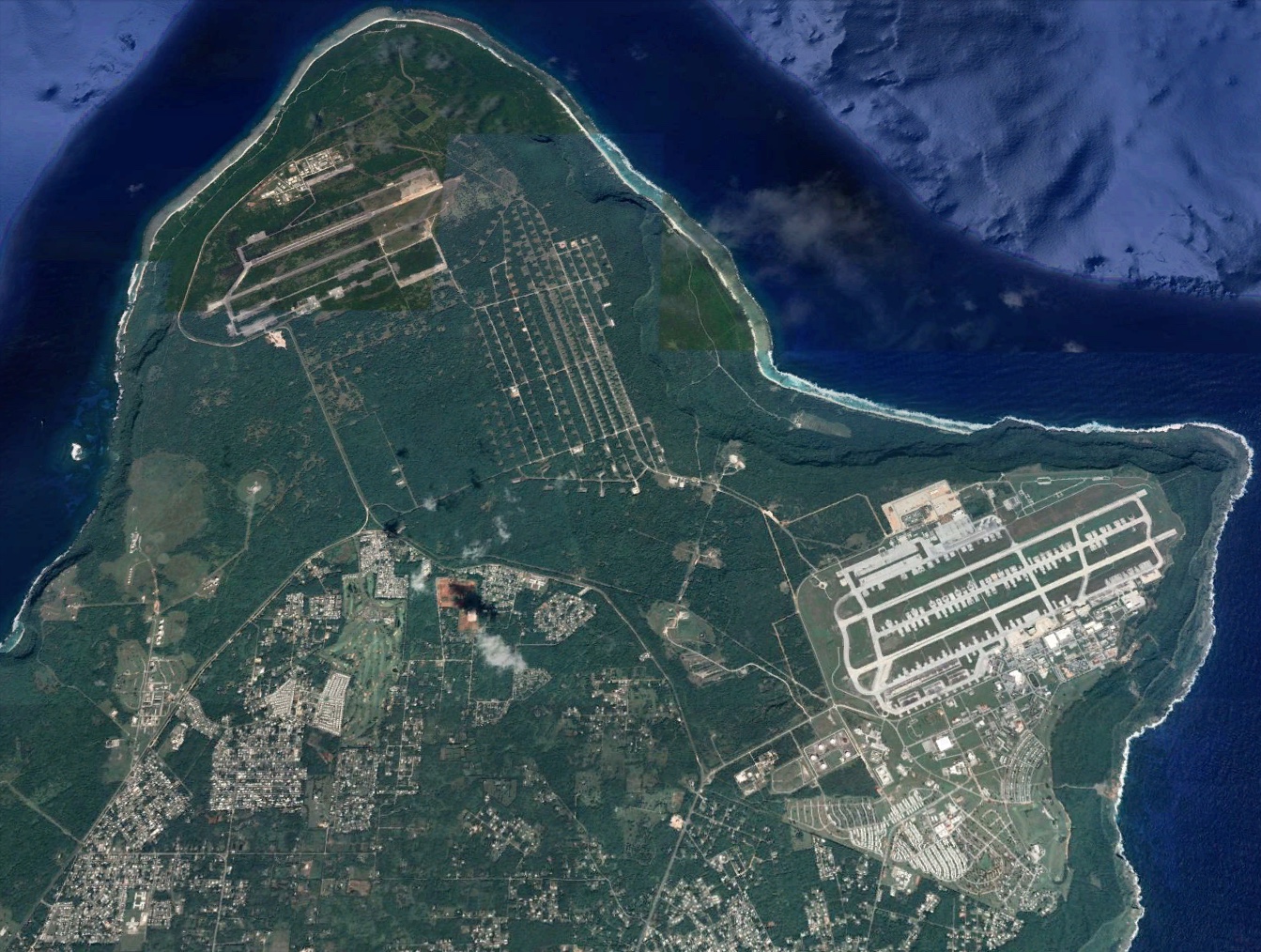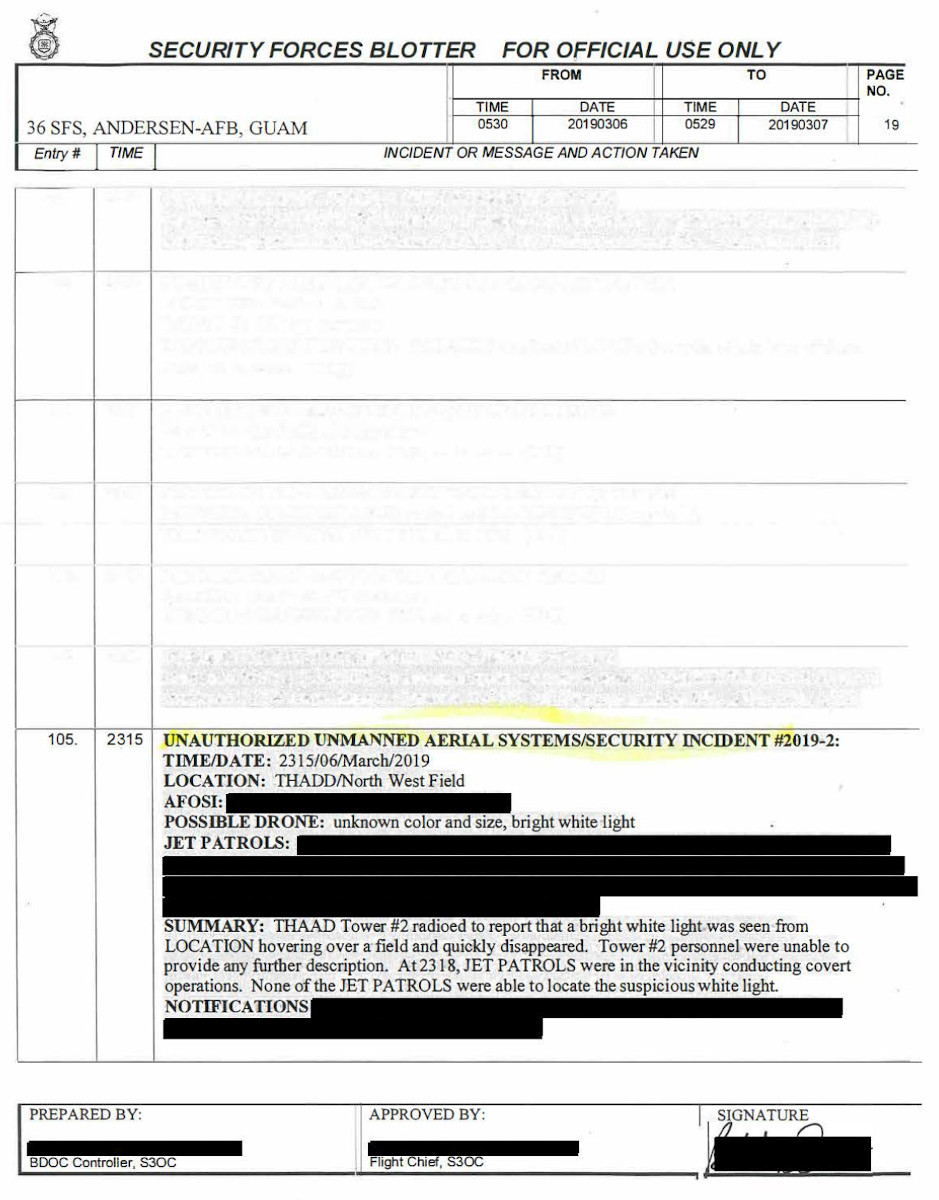Earlier this year, it came to The War Zone‘s attention that a series of bizarre and highly concerning events took place in the late Winter of 2019 at Andersen Air Force Base on the Island of Guam. As we understand it, between late February and early March of last year, the massive installation experienced repeated incursions by unmanned aircraft that appeared to be extremely interested in one highly sensitive area of the highly strategic base, the U.S. Army’s Terminal High Altitude Area Defense (THAAD) battery that is tasked with defending the island from ballistic missile attacks.
The incursions, which were said to have occurred in late March and early April 2019, had been observed by personnel manning guard towers that loom over the highly secure THAAD area situated towards the northern end of the air base, often referred to as “North West Field.” Andersen itself takes up the northern and western reaches of the entire island.

The intruding craft were described as “quadcopter-like” vehicles with bright spotlights that flew from over the water and then across the North West Base area at not much higher than treetop level, about 20 to 30 feet above the ground. On a number of nights, the craft would make multiple incursions in the very early morning hours. They would show up, disappear, then come back a few hours later.
The spotlight that shone down from the craft made it hard for personnel to make out a detailed description of the craft, although estimates range from being three to five feet in diameter largely based on the size of the spotlight. The craft would maneuver dynamically, appearing with the spotlight on, then disappearing, just to reappear moments later over to one side or another with the spotlight on, which was unsettling to those that witnessed it. Supposedly, there was a concerted effort to identify, track, and down the mysterious craft, but it doesn’t seem that those efforts were successful based on our understanding of events.
This information was highly interesting if not downright alarming, but we had to find hard evidence that at least something similar did indeed happen during this timeframe.
We got just that straight from the U.S. Air Force.
The War Zone was able to confirm that at least one of the incidents described above did occur through the Freedom of Information Act (FOIA), by which we obtained a copy of the relevant entry from the Air Force’s 36th Security Forces Squadron’s internal crime blotter. The is unit is part of the 36th Wing at Andersen Air Force Base.
The entry describes the “possible drone” as being of an “unknown color and size, [with a] bright white light.” Army personnel at “THAAD Tower #2” had radioed in at “2315,” or 11:15 PM – it’s unclear if this was local time on Guam or Zulu Time, also known as Greenwich Mean Time – to report “a bright white light was seen from [their] LOCATION hovering over a field and quickly disappeared.”
“Tower #2 personnel were unable to provide any further description,” the blotter entry continues. “At 2318, JET PATROLS were in the vicinity conducting covert operations. None of the JET PATROLS were able to locate the suspicious white light.”

The “JET PATROLS” that are referenced in the document are not aircraft, but are Jungle Enforcement Teams of the 36th Security Forces Squadron. The Air Force describes the teams as being “tasked with preventing security breaches, apprehending poachers, and securing the perimeter around the jungle.” The team’s personnel move silently through the jungle that permeates much of the base at night and have unique human tracking skills. You can read all about this specialized security force in this official media release.
Interestingly, the 36th Security Force Squadron’s blotter lists this incident as “Unauthorized Unmanned Aerial Systems/Security Incident #2019-2,” which implied that there was at least one other similarly classified drone incident at Andersen Air Force Base before this one by that point in the early 2019 calendar or fiscal year. Another FOIA request confirmed that there was a “2019-1” blotter entry, but the Air Force withheld information about that event citing privacy and law enforcement exemptions. Agencies typically withhold records for law enforcement reasons because of a potential risk of exposing sensitive tactics, techniques, or procedures, or because of an ongoing investigation. It is then doubly interesting that the March 2019 incident near the Army’s THAAD battery at North West Field was not also subject to the exemptions.
U.S. Indo-Pacific Command (INDOPACOM) forwarded a separate FOIA request regarding this incident, any other similar occurrences around the same timeframe, to the U.S. Army. The War Zone is still awaiting a response to that request, as well as another one to the Guam Police Department. We inquired directly to the 36th Wing and INDOPACOM, but never got a response.
We found this information to be highly troubling for a number of reasons. The most important is that this craft was able to penetrate its way over an air defense system that is tasked with defending the highly strategic island from ballistic missile attacks. In other words, that THAAD battery is largely what stands in the way of a country like North Korea from holding the island at imminent risk. The system is even capable of shielding against a lower volume barrage from a peer state competitor, such as China.

Guam would be near the top of Beijing’s targeting list during a conflict with the United States and its growing ballistic missile arsenal has been developed largely to deny the U.S. the utility of its regional bases during the open stages of a conflict. The island has already been outright threatened by Kim Jong Un’s regime.

The thing is that destruction of enemy air defenses (DEAD) is not defined by a platform, it is a mission. Traditionally we associate the objective of destroying enemy air defenses with standoff cruise missile attacks and ‘wild weasel’ fighter jet operations, but DEAD can be carried out by a team of special operators with some well-placed explosives or via a barrage of naval gunfire. Even carefully deployed malware that targets the software that an air defense system and its mechanical component run on could potentially be destructive enough to be considered a DEAD method.
With that said, America’s preeminent adversaries in the entire region would make taking out the THAAD battery on Guam a top priority during a conflict or even as part of a limited demonstration of force. Why barrage it with ballistic missiles or attempt a cruise missile launch from a forward-deployed submarine or even a clandestine commando raid when you can just fly a drone loaded with explosives into it? And no, you don’t need some high-end drone system to do this as real-world events have highlighted many times over. Drug cartels are now whacking their enemies with off-the-shelf drone-borne improvised explosive devices and even U.S. allies are actually manufacturing hobby-like drones just for this purpose. Somewhat more sophisticated types can be launched from longer distances and can even home in on radar or other RF emissions sources, like THAAD’s powerful AN/TPY-2 Radar and data-links, autonomously, beyond just striking a certain point on a map.

Simply put, ‘shooting the archer,’ in this case an advanced anti-ballistic missile system that protects America’s most strategic base in the entire region, via a relatively cheap drone is both an absurdly obvious and terrifyingly ironic tactic—the U.S. can shoot down ballistic missiles, but the critical systems used to do so remain extremely vulnerable to the lowliest of airborne threats—cheap drones.
For those that follow our work, this is not news. The U.S. military was dangerously aloof when it came to the threat posed by low-end drones. We spent years highlighting this threat while seeing the U.S. military do very little to actually counter it, that is until ISIS was constantly dropping bomblets from drones or just flying explosive-laden drones into allied positions during the Battle of Mosul, Iraq.
The threat has ballooned exactly as we predicted since then, with mass drone attacks on forward operating bases, attempted assassinations of ruling figures via drone, and even a successful drone assault right at the heart of Saudi oil production a year ago. In fact, the threat has gotten so bad that top U.S. commanders in the field are saying the constant presence of nefarious drones over or near their troops and equipment is what keeps them up at night.
In the meantime, it’s abundantly clear that even America’s most capable air defenses are vulnerable to the most meager of aerial capabilities—commercially available drones. If anything else, this is yet another, but possibly the biggest example of just how misplaced the U.S. military’s priorities had become when it comes to investments in air defense over the last two decades or so. You can read how the Pentagon let its short-range air defense (SHORAD) capabilities wither on the vine to an appalling degree while concentrating on higher-profile, ‘sexier,’ and drastically more lucrative weapon systems in this past feature of ours. The Pentagon’s appalling lack of vision regarding the emergence of this threat has made quickly ramping-up efforts to counter it that much more of a scramble, which is ongoing now. Still, America’s potential enemies are already a step ahead, working on swarming low-end drone concepts that will overwhelm most countermeasures currently in the works.
So what is happening here? How does this all play into a rash of other troubling drone sightings, including highly similar ones that have occurred over American nuclear facilities and in other highly restricted airspace, as well as the ongoing buzz about unidentified aerial phenomena (UAP)? We will tie years worth of reporting on all these issues and others together very soon in a capstone piece.
In the meantime, the events on Guam in 2019 serve as maybe the most outstanding reminder of how the Pentagon’s fixation on high-end threats, and the huge gold plated weapons programs that are put into play to counter them, have left even those very capabilities remarkably vulnerable to far less advanced attacks.
Contact the authors: Tyler@thedrive.com and Joe@thedrive.com
